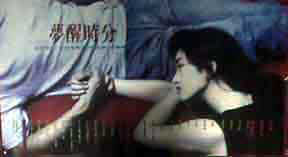Mary from Beijing

Reviewed by YTSL
The crew list of this 1992 effort is rather impressive.
So much so, in fact, that this moviephile had to rewind and rewatch the movie's
beginning scenes a couple of times since I seriously got distracted by its
opening credits, which continued to appear on screen as the film -- complete
with subtitled translations of the dialogue -- unfolded. For in addition
to Sylvia Chang (whose "Tempting Heart" was selected by the Asian edition
of Time magazine as one of its top ten films of 1999) as its director and
scriptwriter, Zhang Yimou (yes, the director of "Ju Dou", "Raise the Red
Lantern" and "The Story of Qui Ju") is named as executive producer plus frequent
Wong Kar Wai collaborators, art director William Chang and cinematographer
Christopher Doyle also worked on this production.

It's also transnational even if Chinese (At this point, Christopher Doyle
is pretty much considered to be at least an honorary Chinese man!):
What with its director being from Taiwan and its female lead (Gong Li) as
well as executive producer hailing from Mainland China along with the bulk
of its cast (led by Kenny Bee) -- and presumably its crew -- being Hong Kong
residents. Perhaps it ought not to come as too much of a surprise then
that the movie itself reflects this. For example, MARY FROM BEIJING's
two main characters are: A Hong Kong businessman who is newly returned
from England and looking into setting up a factory in China; and a "kept
woman" who was born in Hong Kong but who had only recently returned to her
birthplace after being brought by her parents to live in Beijing, and consequently
is not that fluent a Cantonese speaker (something which is taken advantage
of by Peter (played by Wilson Lam), her "boyfriend"). Also, while the
movie takes place principally in what was then a British crown colony, a
locale where English was prized and spoken more than Mandarin (or Putong
Hua, as Kenny Bee's character -- conveniently named Ken -- notes that the
Mainland Chinese call it), there are some really interesting scenes which
take place in the capital of the People's Republic of China as well as an
amusing one involving Taiwanese tourists.

I'm still not sure whether it was deliberate but do feel that the film only
really perked up and got -- maybe gained in -- meaning when it accompanies
Ken on what was essentially the tissue paper business executive's personal
as well as professional reconnaissance trip to China (to see what opportunities
there would be for him there but also to make connections with real Chinese
people (rather than just its government officials)). Until then, MARY
FROM BEIJING looked like a beautifully shot (there are quite a few lingering
views of Gong Li...drinking, in bed, playing with her pet dog, being lonely,
looking sad, etc.), slow paced, simple and personal movie of two neighbors
and their growing friendship -- based on his looking for someone who could
teach him Mandarin and Ma Lei (whose name, we are told, sounds like Mary!)
looking for someone who could teach her Cantonese and English -- which had
possibilities for turning into a romance.

Yes, it did have a few amusing scenes (including of Ken's trip to a dentist
and its aftermath, plus meetings with a live-wire entrepreneur-type (played
by Jan Lamb) who wished aloud at one point that he could encounter Cherie
Chung as frequently as he did Ken (In turn, the older man responded by wishing
that the youth could be Brigitte Lin Ching-Hsia!)). But, frankly, the
first half of the film was not really succeeding in holding my complete interest.
Not like the following observations made by Ken to Ma Lei after his return
from Beijing:- "Hong Kong is like a beautiful woman. Everyone wants
to possess her, but is unwilling to marry her. So it's best to be a
romantic and submissive mistress. She'll strive for status first but
when she fails, she'll realize that the only thing that can protect her is
to go for money while she still is young. Only money can enable her
to live with dignity. This is not her tragedy but ours because we don't treasure
her enough. People are ever in transit, pursuing her beauty but refuse
to share her pain." In a film which subtly and artfully contains references
to Tian An Men Square and the Cultural Revolution, it is difficult -- at
least for this (re)viewer -- not to see these rather interesting remarks
as unrelated to the British treatment of Hong Kong, Hong Kong's response
to her colonized status and those of her residents who circa 1992 were planning
to emigrate rather than stay on in the territory after its Handover to China.

N.B. In my continuing exploration of the world of Hong Kong movies, I am
developing a strong appreciation of the -- directing, writing and acting
-- accomplishments of Sylvia Chang. On the basis of what I have so
far seen (For the record: Not much at all!), this is a woman whose
offerings are thoughtful and sensitive without being too serious, all that
depressing and obviously eccentric. Maybe her body of work (especially
her behind the camera later ones) is not relentlessly downbeat, quirky and
flashy enough to be respected or hailed by the artsy or other crowds.
This one (re)viewer though will own to loving what may be an almost trademark
sweet maturity that I have found so far in "Tempting Heart", "I Want To Go
On Living" and, now, MARY FROM BEIJING.

My rating for the film: 8.5.






